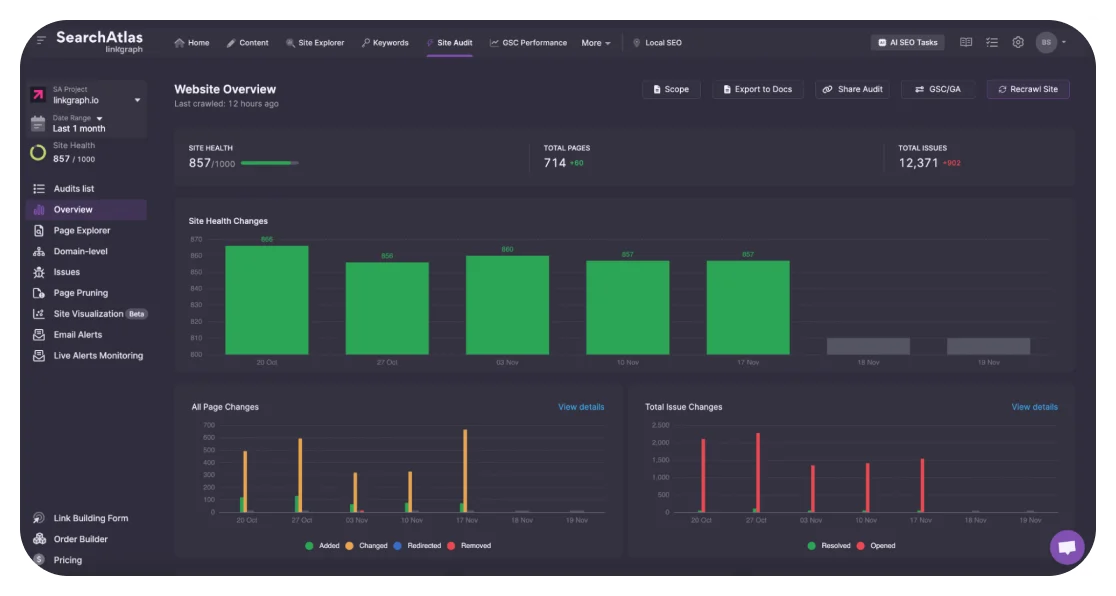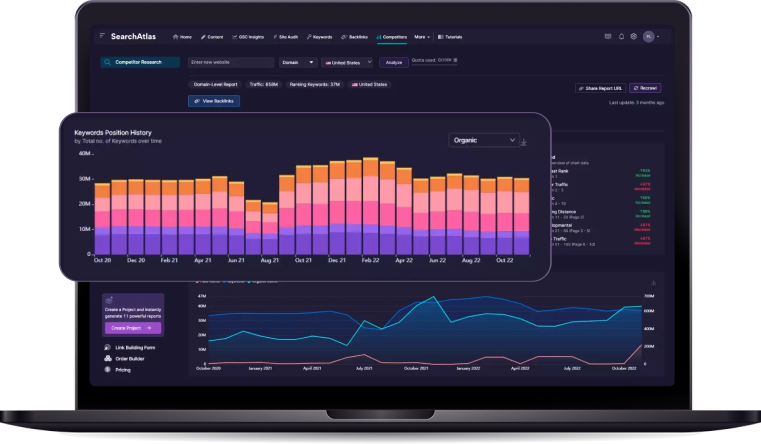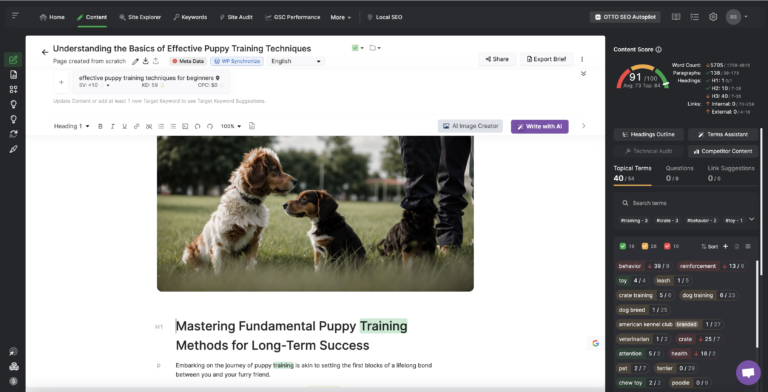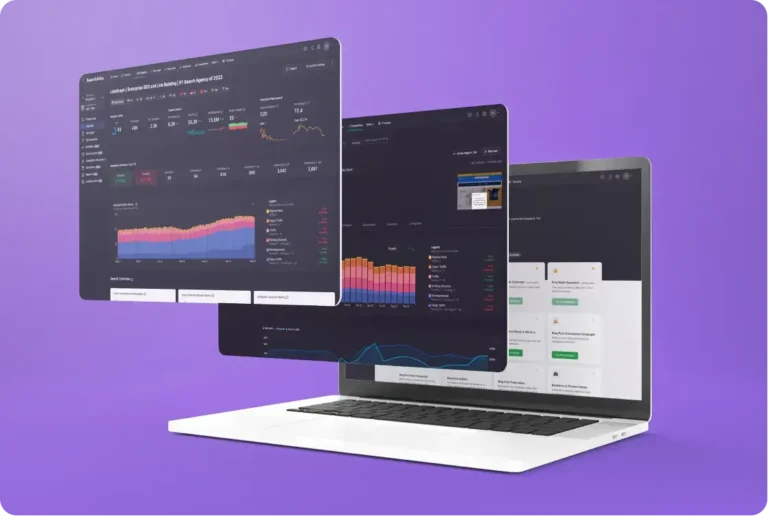Mastering Audience Analysis: A Comprehensive How-to Guide
In the realm of digital marketing, understanding your audience is paramount for tailoring impactful campaigns and messages.
As a pivotal element for boosting engagement and conversion, audience analysis provides the scaffold for a data-driven strategy that resonates with your intended group.
Through meticulous research and the application of advanced tools like Search Atlas, marketers can uncover profound insights into audience behavior, preferences, and pain points.
This article will guide you through the indispensable steps to master audience analysis, equipping your marketing campaign with the precision of a well-tuned orchestra.
Keep reading to transform your audience data into a symphony of targeted, effective communication.
Key Takeaways
- Audience Analysis Is Essential for Tailoring Marketing Strategies to Customer Preferences and Behaviors
- Tools Like Search Atlas Provide Critical Insights for Optimizing SEO and Content Marketing
- Psychographic Characteristics Are Pivotal for Crafting Resonant Messages and Engaging Diverse Audience Segments
- Continuous Evaluation and Adaptation of Marketing Strategies Are Crucial for Long-Term Success
- Fresh Data Collection and Audience Feedback Inform and Enhance Targeted Content Strategies
Define Your Objectives for Audience Analysis

Embarking on audience analysis is a critical venture for companies aiming to sharpen their marketing strategies and bolster engagement.
Prior to diving into the granular specifics of audience data, it is imperative to clearly define the objectives that will guide the entire probing process.
Objectives serve as a compass, directing focus toward the end goals, illuminating the path for key inquiries that need addressing, and shaping the metrics to quantify audience engagement.
By pinpointing these aims, a company lays the groundwork for a methodical and results-oriented analysis.
This paves the way for tailored content on platforms such as Search Atlas, which provides tools like Search Atlas’ Content Planner and Blog Ideas, designed to optimize one’s marketing campaign according to the nuanced preferences of their target group.
Determine Your End Goals for the Analysis
The pursuit of audience analysis demands a clear vision of what a company intends to achieve. Whether looking to influence buying behavior, enhance customer satisfaction, or drive product development, it is crucial to define precise and measurable objectives. These goals not only streamline the approach but also facilitate a pointed evaluation of the marketing campaign’s efficacy.
Executing a triumph in audience analysis hinges on determining both qualitative and quantitative goals. Setting targets such as increasing brand awareness by a specific percentage, or growing audience engagement in a particular demographic, transforms abstract ambitions into actionable benchmarks:
- Analyze consumer behavior to understand the prevailing market trends.
- Examine customer feedback to refine product offerings.
- Study audience profiles to deliver personalized marketing communications.
With granular targets in place, organizations can utilize tools like Search Atlas’ Domain Authority Checker and Backlink Analyzer to gather insights that inform strategic decisions and foster an effective marketing campaign.
Identify Key Questions You Want Answered
Determining the specific questions a company seeks to address is the backbone of a coherent audience analysis. These inquiries anchor the research and ensure that each piece of collected audience data is relevant and tied to the business’s strategic goals.
The specificity of these questions enables the refinement of marketing campaigns, for it is not merely the accumulation of data that provides insight, but the thoughtful interrogation of that data:
- How does the age or life stage of our customer affect their purchasing decisions?
- Which keywords are our target audience using when searching for solutions we offer?
- What are the content consumption patterns across different segments of our audience?
Set Clear Metrics for Audience Engagement
Establishing concrete metrics for audience engagement is essential for any company seeking to track the performance of their marketing outreach and, by extension, their content’s influence. Measures of success might range from the frequency of user interactions with a blog post to the conversion rates stemming from a newsletter crafted using Search Atlas’ On-Page Audit Tool. These metrics turn abstract audience data into palpable results that can steer future content strategies and PPC campaigns.
In the complex landscape of modern digital marketing, tools such as Search Atlas’ SEO AI Otto become indispensable for parsing through large sets of audience data to determine the efficacy of each deployed strategy. Insightful metrics such as click-through rates or time spent on a page allow managers and staff to pinpoint which elements of their audience outreach are resonating and, equally important, which are not. This data-driven scrutiny affords a degree of precision in refining the approach to truly captivate the intended audience.
Identify Your Target Audience Segments

Effective audience analysis pivots on an intimate understanding of the diverse fragments that constitute the broader customer base.
A meticulous dissection of market demographics provides a skeletal outline of the audience, yet it’s the exploration of psychographic characteristics that breathes life into customer profiles, revealing the values and attitudes that influence their decisions.
Furthermore, segmenting these profiles based on observed behaviors allows for a more dynamic and responsive approach to engagement.
This initial step is foundational, setting the stage for a finely-tuned marketing strategy tailored to the distinct facets of the audience mosaic.
Break Down Your Market Demographics
In the realm of audience analysis, dissecting market demographics is akin to mapping the contours of a geographic landscape. Detailing elements such as age, gender, marital status, race, and geographical location equips a company with essential baseline data to form initial audience segments. This segmentation forms an indispensable part of constructing audience profiles, ensuring companies engage with their market with pinpoint accuracy.
Empowered with demographic insights, businesses can wield Search Atlas’ Site Explorer and Backlink Analyzer, leveraging these comprehensive tools to more precisely navigate the intricate web of audience engagement. With demographics in sharper focus, campaigns are strategically honed, targeting not just an indiscriminate multitude but rather, a well-defined audience with whom the company’s message will most resonate.
Explore Psychographic Characteristics of Your Audience
Exploring the psychographic characteristics of an audience sheds light on the psychological attributes that delineate consumer behavior: values, attitudes, interests, and lifestyle choices. This exploration delves beyond surface-level demographics, allowing companies to understand the inner motivations that drive their audience’s actions and preferences.
Such an understanding is pivotal in crafting messages that resonate on a deeper level, ensuring that marketing campaign communications are tailored not only to the who but also to the why of consumer behavior. Through this intricate layer of analysis, brands position themselves to create content with the potential to forge a stronger, more personal connection with each audience member.
| Psychographic Dimension | Questions to Address | Tools for Analysis |
|---|---|---|
| Values | What core beliefs guide the audience’s choices? | Search Atlas’s Keyword Research |
| Attitudes | How does the audience perceive our brand and products? | On-Page Audit Tool |
| Interests | What topics or activities captivate our audience? | SEO AI Otto Analysis |
| Lifestyle | What everyday patterns or habits influence the audience’s spending decisions? | Site Explorer Insights |
Segment Your Audience Based on Behaviors
Segmenting the target audience by their behaviors is an insightful practice that uncovers patterns crucial for crafting compelling marketing strategies. It hinges on tracking and interpreting actions such as purchase history, website navigation paths, and interactions with digital campaigns. These behavioral insights enable Search Atlas users to design content and offers that resonate more profoundly with their audience’s current needs and preferences.
Observing the audience’s online behavior through the lens of Search Atlas’ advanced tools like the Topical Map or Site Explorer helps create distinct profiles that can be targeted with precision. Companies that invest in behavioral segmentation recognize shifts in usage and engagement, allowing them to anticipate audience needs and adjust their strategies in real-time for maximum impact and conversion efficiency.
Utilize Effective Data Collection Methods

In mastering the multifaceted operation of audience analysis, the method of data collection becomes a pivotal element in gaining actionable insights.
Surveys provide direct communication with customers, eliciting valuable information about their needs and perceptions.
Meanwhile, harnessing tracking tools delivers a comprehensive view of online behaviors, painting a clear picture of user interactions and engagements.
Additionally, social listening offers a conduit to real-time feedback, capturing the sentiments and conversations of consumers as they unfold across various platforms.
The convergence of these methodologies arms businesses with the detailed intelligence required to fine-tune marketing efforts and architect campaigns with precision.
Conduct Surveys for Direct Audience Insights
Engaging directly with an audience through surveys is a potent method for extracting precise insights into customer preferences and opinions. This form of data collection allows businesses to pose specific questions that delve into the factors influencing consumer behavior and satisfaction.
By employing well-crafted questionnaires, companies are poised to gather feedback that can validate assumptions and highlight areas for innovation and improvement. The actionable data culled from these responses equips marketers with the wisdom needed to enhance user experience and sharpen their marketing tactics.
| Survey Objective | Data Collection Tool | Expected Insight |
|---|---|---|
| Customer Satisfaction Measurement | Online Polling Platforms | Feedback on product experience and service quality |
| Product Development Input | Interactive Feedback Forms | Consumer desires and pain points |
| Brand Perception Analysis | Social Media Survey Systems | Audience attitudes towards brand image and messaging |
Implement Tracking Tools to Observe Online Behaviors
The vigilant observation of online behaviors through sophisticated tracking tools is paramount for any enterprise seeking to understand the digital footprints of their users. Tools such as Search Atlas’ Site Explorer offer a powerful lens through which a business can discern the intricacies of user interaction with their digital presence, including page views, dwell times, and navigation patterns.
Deploying these technological observers equips organizations with the capacity to capture a wealth of data, revealing not only the content that engages but also identifying potential friction points within the digital experience. This actionable intelligence is critical for informing effective adjustments to SEO and content marketing strategies, ensuring that every nuance of user behavior informs and enhances future marketing campaigns.
Tap Into Social Listening for Real-Time Feedback
Discovering the pulse of audience sentiment happens in real-time with social listening. By monitoring social platforms, businesses can catch the wave of customer feedback as it happens, enabling a responsive approach to customer engagement and brand management.
- Identifying trending topics relevant to the brand’s market.
- Capturing immediate audience reactions to campaigns or events.
- Gauging sentiment around products, services, and overall brand perception.
Social listening tools offer an ongoing stream of consumer insights, pivotal for adjusting strategies to align with audience expectations. This continuous flow of feedback allows businesses to remain agile, adapting their messaging and tactics to remain in harmony with the evolving conversation surrounding their brand.
Analyze Audience Feedback for Actionable Insights

Peering into audience feedback is akin to unlocking a trove of strategic insights, where the intimate details of consumer preferences and behaviors come to light.
Interpreting this feedback demands a multi-faceted approach that distills key themes from survey responses, scrutinizes analytics for user journey comprehensions, and tunes into social media to gauge the prevailing audience sentiments.
Each of these components contributes to a holistic understanding of the audience, enabling businesses to craft an informed and impactful response.
Sleuthing through the layers of feedback paves the way for brands to not only listen but to interpret and act, ensuring that every facet of their audience analysis translates into strategic, data-driven decisions that accentuate their marketing endeavors.
Interpret Survey Responses for Key Themes
Decoding survey results into key themes is essential for understanding the broad concerns and delights of an audience. Cohesive patterns emerge from this analytical process, providing managers and content creators with a clear set of priorities for action.
Extraction and emphasis on these recurring motifs support a strategic alignment of marketing efforts with audience needs and expectations. Identifying these themes fuels the development of focused narratives and ensures that every piece of communication is a step towards fulfilling the audience’s desires:
- Isolating prevailing topics that captivate the audience’s interest.
- Recognizing repeated suggestions or critiques for refinement.
- Highlighting shared user experiences that inform product enhancement.
Once articulated, these central themes serve as pillars for structuring compelling blog posts, newsletters, and campaign copy. They provide an essential reference to ensure that all created content is resonating with and providing value to the target audience.
Use Analytics to Understand User Journeys
Utilizing analytics to comprehend user journeys sheds light on the pathways audiences traverse when engaging with a company’s digital landscape. This insight is vital, charting each touchpoint – from initial exposure to final conversion – and unveiling the narrative of customer engagement.
Through diligent analysis, organizations are empowered to identify key stages within the consumer journey that affect the overall experience. A detailed mapping of these interactions, marked by clarity and precision, informs strategic modifications that companies can implement to streamline the user’s path to their desired outcome:
| Consumer Journey Stage | Insight Gained | Potential Action |
|---|---|---|
| Initial Engagement | First points of contact and content that captivates | Optimize entry-level content for greater allure and relevance |
| Mid-Journey Interaction | Preferred channels and resources utilized by users | Tailor communication and resources to preferred user channels |
| Conversion Point | Elements that contribute to the decision-making process | Enhance user interface and calls to action for increased conversions |
Monitor Social Media for Audience Sentiments
Monitoring social media is a vital gauge of public opinion, revealing unfiltered audience sentiments that can significantly inform a company’s marketing strategy. Through active observation of discussions, companies can discern real-time customer perceptions, rapidly identifying both positive affirmations and areas that may warrant immediate attention or improvement.
Engagement with social media empowers businesses to keep a finger on the pulse of the market, allowing them to swiftly react and adapt to unfolding trends and feedback. This close dialogue with audience members offers a window into the impact of marketing initiatives, delivering a clear view of what resonates and what may fall flat within diverse audience segments.
Craft Your Content Strategy Based on Analysis

With the foundational elements of audience analysis established through meticulous data collection and strategic interpretation, businesses stand at the precipice of sculpting a content strategy with unwavering precision.
The ensuing phase is a creative confluence between audience insights and content creation, where the development of personas, tailored messaging, and a discerning content calendar becomes paramount.
These elements coalesce to form a robust strategy that not only engages but also converts, ensuring every piece of content deployed aligns with the nuanced tastes and preferences of each unique audience segment.
Develop Personas to Guide Content Creation
The formulation of audience personas stands as a cornerstone in the architecture of a content strategy, effectively serving as blueprints that inform the writer on crafting messages that resonate. Personas synthesize audience data into tangible constructs, enabling content creators to visualize and address the specific needs, challenges, and aspirations of distinct user segments within their strategy.
With these detailed profiles, companies and their marketing teams move beyond generic appeals to create nuanced content that speaks directly to the core of each persona’s identity. This personal touch imbues the marketing campaign with a sense of relevance and authenticity, significantly enhancing the potential for audience engagement and conversion.
Tailor Messaging to Resonate With Each Segment
Crafting content that resonates with each segment implies an intimate grasp of the audience’s language and culture, involving a strategic interplay of word choice and thematic relevance. For writers and marketers alike, the challenge lies in aligning the tone, style, and substance of messaging to reflect the unique characteristics and preferences of each audience fragment. By doing so, brands effectively strike a chord with each subgroup, generating a sense of affinity and increasing the likelihood of engagement.
With psychographic and behavioral insights in hand, companies must navigate the fine line between personalization and scalability in their messaging. Employing Search Atlas as the fulcrum for this balancing act, teams can leverage the platform’s SEO and content optimization tools to calibrate their copy with precision, ensuring that every sentence, image, and call-to-action is thoughtfully designed to resonate with the designated recipient’s intrinsic motivators and identified patterns of interest.
Plan Content Calendars Around Audience Preferences
Seamlessly integrating the preferences of target audiences into content calendars is the linchpin for ensuring the delivery of timely and resonant communications. By aligning content schedules with key dates, seasonal interests, and consumption patterns identified through audience analysis, companies enhance the relevance and impact of each marketing initiative.
Establishment of a content calendar tailored to audience preferences requires thoughtful strategizing and keen attention to detail:
- Assess peak engagement times and preferred content formats of different audience segments.
- Coordinate content themes with industry events or trending topics to maximize topicality and interest.
- Incorporate feedback loops into the calendar to refine and adjust messaging based on audience reception and interaction.
Measure Success and Refine Your Approach

In the competitive landscape of digital marketing, the ability to measure success and refine your approach is as critical as the initial strategy itself.
For businesses embracing the nuances of audience analysis, this continuous cycle of evaluation and adaptation ensures their marketing efforts remain aligned with the dynamic spectrum of consumer behavior.
Tracking engagement metrics against carefully set objectives, adjusting strategies in response to audience feedback, and maintaining a steady stream of fresh data are fundamental steps in the ongoing journey to marketing prowess.
It’s through this iterative process that companies can sustain relevance and optimize their campaigns to achieve sustained growth and customer loyalty.
Track Engagement Metrics Against Your Objectives
Accurate tracking of engagement metrics against predefined objectives is essential for businesses to gauge the success of their marketing campaigns. Metrics provide a quantifiable lens through which to view audience behavior, from the click-through rates on a targeted PPC strategy to the social shares of a compelling blog post.
These performance indicators act as watchdogs that alert a company to both triumphs and areas needing adjustment, offering insights into the resonance of their content with the specified target audience. Armed with this data, marketers can fine-tune their approaches, ensuring a tailored fit between audience expectations and the company’s strategic communication:
| Objective | Engagement Metric | Significance |
|---|---|---|
| Increase Brand Awareness | Social Media Impressions | Quantifies reach of content and brand visibility |
| Enhance User Experience | Bounce Rate | Indicates relevance and engagement of site content |
| Boost Conversion Rates | Conversion Rate Percentage | Directly measures efficacy of content in driving actions |
Adjust Strategies Based on Audience Response
Refining strategies in light of audience response is an agile marketer’s strategic move toward cultivating resonance and driving campaign success. This adjustment process places the audience’s voice at the forefront, dictating the evolution of content and approaches based on feedback and user interaction.
Marketers committed to audience-centric strategies value response analysis as a mechanism that fuels continuous improvement. By refining methodologies with data-backed insights, companies demonstrate adaptability and responsiveness to their users’ evolving needs and preferences, maintaining the momentum of engagement and conversion.
| Original Strategy | Audience Feedback | Adjusted Strategy |
|---|---|---|
| Content Frequency | Desire for more in-depth articles | Less frequent but more comprehensive posts |
| CTA Placement | User feedback indicating CTAs are intrusive | Subtle, contextually integrated calls-to-action |
| Email Campaign Style | High unsubscribe rates | More personalized, less sales-focused emails |
Continuously Gather Data to Keep Your Analysis Up-to-Date
For companies aiming to hone their marketing craft, the acquisition of fresh data is a continual imperative. The ever-changing marketplace dictates that audience analysis is not a one-time event but a recurring endeavor, necessitating regular updates to data sets to capture evolving trends in consumer behavior, preferences, and feedback.
Maintaining currency in audience data ensures that marketing strategies remain agile and effective. In leveraging tools such as Search Atlas, organizations can automate much of this data collection process, enabling constant refinement of strategies to meet the shifting landscape of audience expectations and maintain a competitive edge.
Frequently Asked Questions
Why is it important to define objectives for audience analysis?
Defining objectives for audience analysis is a cornerstone in tailoring marketing campaigns that resonate with the target demographic, thereby increasing engagement and conversion rates. It also allows companies to align their messaging with the specific needs and interests of their audience groups, ensuring a more effective and impactful communication strategy.
How can identifying target audience segments help optimize marketing campaigns?
Identifying target audience segments enables marketers to tailor content and strategies to the specific needs and preferences of different groups, leading to more effective and efficient marketing campaigns. This targeted approach often results in enhanced engagement, higher conversion rates, and an increased return on investment by ensuring that marketing efforts resonate more closely with the intended recipients.
What are some effective methods for collecting data on your target audience?
Effective methods for collecting data on your target audience include leveraging audience analysis tools, such as Search Atlas, conducting surveys and interviews to gather qualitative insights, and utilizing social media analytics to understand audience behavior and preferences. Another valuable approach involves mining customer feedback and support interactions to derive common pain points and needs specific to your audience profile.
How can analyzing audience feedback provide actionable insights for your company?
Analyzing audience feedback offers a wealth of insights, enabling companies to tailor their products and services to better meet customer needs and preferences. This process not only highlights areas of success but also identifies opportunities for improvement, fostering a customer-centric approach that can drive company growth and enhance market positioning.
Why is it necessary to craft a content strategy based on audience analysis?
Crafting a content strategy based on audience analysis is essential because it ensures that the material resonates with the target demographic, effectively engaging and influencing their actions. A tailored strategy derived from audience data heightens the relevance and impact of marketing campaigns, building a stronger connection between the customer and the product or company.
Conclusion
Mastering audience analysis is crucial for businesses to craft impactful marketing strategies and ensure ongoing success.
By clearly defining objectives, asking targeted questions, and setting concrete engagement metrics, companies develop a focused approach for analyzing and understanding their audiences.
Segmenting the audience further by demographics, psychographics, and behaviors allows for a strategic, personalized communication method.
Employing effective data collection methods, including surveys, tracking tools, and social listening, provides a well-rounded view of the customer landscape.
Interpreting feedback, monitoring user journeys, and keeping a close watch on social media sentiments enables businesses to adapt their content strategies accordingly.
Furthermore, developing personas, tailoring messaging, and planning content calendars based on audience preferences lead to more engaging and relevant campaigns.
Finally, continuously measuring success through engagement metrics and adjusting strategies based on audience feedback ensures that marketing efforts are not only precise but also align with consumer needs and evolve with the market.
Thus, keeping data updated is essential for adapting strategies effectively, guaranteeing that a company’s marketing remains resonant and competitive.









